I believe this bird to be the darkest dark morph Swainson’s Hawk I’ve ever encountered.
There are three color morphs in Swainson’s Hawks – light, intermediate and dark. However, individuals in each group don’t look exactly alike as there are significant variations. So first, here’s a quick look at a fairly typical bird in each category.
This hawk is a light morph – by far the most common of the three color phases. I believe this bird has a bloody lower belly which isn’t part of the normal color down there.
And here’s an intermediate morph.
Another look at the same bird – this time in flight so we can see more of its ventral surface.
And this is a fairly typical dark morph Swainson’s. Dark morphs are the rarest of the three color phases so I very seldom see or photograph them. In fact I believe I’ve only seen a handful of truly dark morphs in the last ten years. I encountered this one a few years ago in dark and stormy conditions in Montana’s Centennial Valley. Most dark morphs have at least some white on their face just as this bird does. Many have more white than this.
1/1250, f/7.1, ISO 640, Canon 7D Mark II, Canon EF 500mm f/4L IS II USM, not baited, set up or called in
But two days ago I photographed this striking dark morph in northern Utah. It’s colors were slight variations of a deep chocolate-brown. I was very excited to see this bird and I was afraid that it would fly off before I could pop off a few shots but in the end it turned out to be one of the “tamest” adult buteos I’ve ever photographed. The only complaint I have is that it gave me very little pose variety but here I caught it giving me the best coy look it could muster.
As stated in the ABA Blog about a different dark morph Swainson’s – “the lack of even a little white on the face points to a truly dark-morph Swainson’s Hawk, as opposed to a rufous/intermediate or dark intermediate morph“.
1/3200, f/6.3, ISO 640, Canon 7D Mark II, Canon EF 500mm f/4L IS II USM, not baited, set up or called in
I wanted to get a little better look at the breast color of this bird so I began to creep forward in my pickup very slowly on the road, fully expecting the hawk to spook but it didn’t even twitch or look the least bit nervous. Here I’m nearly directly across from it on the road and this image was shot vertically in order to get the entire bird in the frame. This photo has been cropped very little.
1/2000, f/7.1, ISO 500, Canon 7D, Canon EF 100-400mm f/4.5-5.6L IS II USM @ 227mm, not baited, set up or called in
Here I’m slightly past the hawk and even with me this close (now I’ve switched to my smaller zoom lens) it was comfortable enough to preen and scratch its face. After quite a while it flew off, not because it was nervous in my presence but just because it apparently felt the urge to do so.
1/2000, f/7.1, ISO 500, Canon 7D, Canon EF 100-400mm f/4.5-5.6L IS II USM @ 200mm, not baited, set up or called in
It didn’t fly far and I was able to get off a few shots with the hawk on its new perch.
There are dark morphs of several other North American buteo species but the only other one I ever see is the dark morph Ferruginous Hawk. The darkest birds of all species are in a strong minority so I was absolutely delighted to be able to spend some quality time with this stunning and unusual bird.
Ron


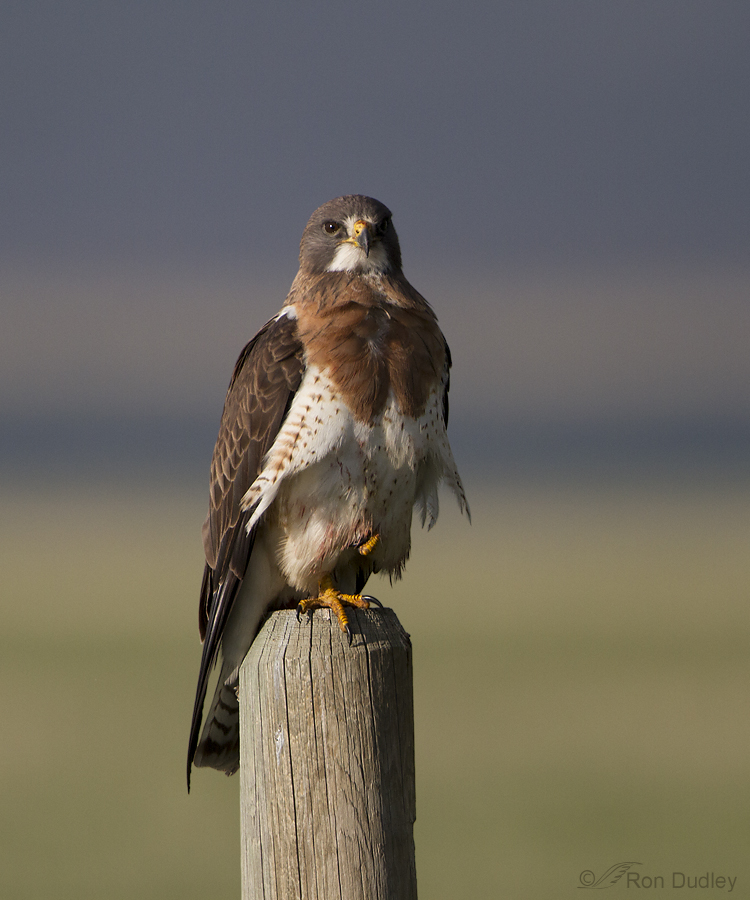
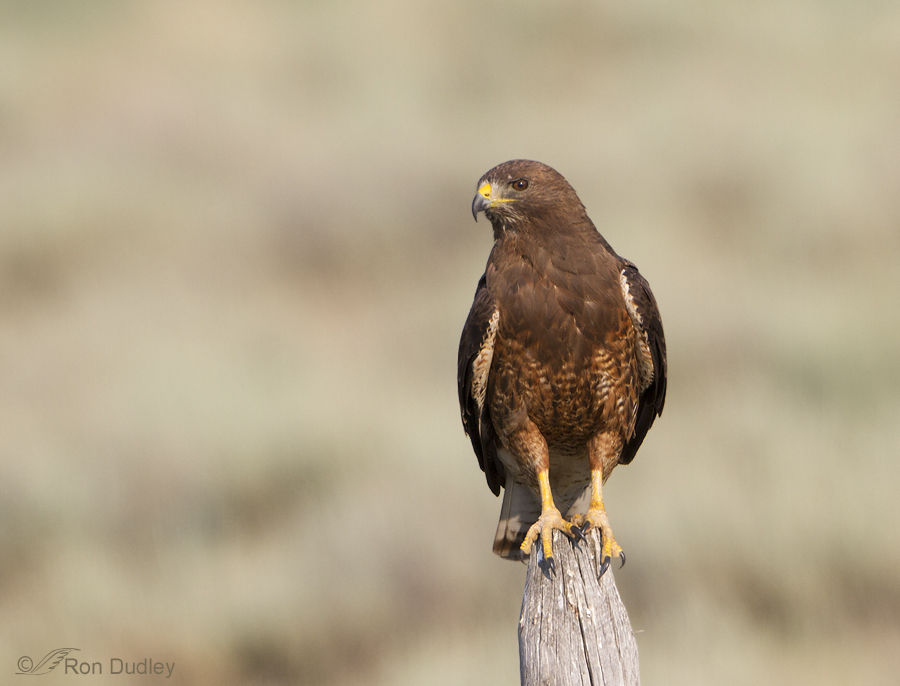
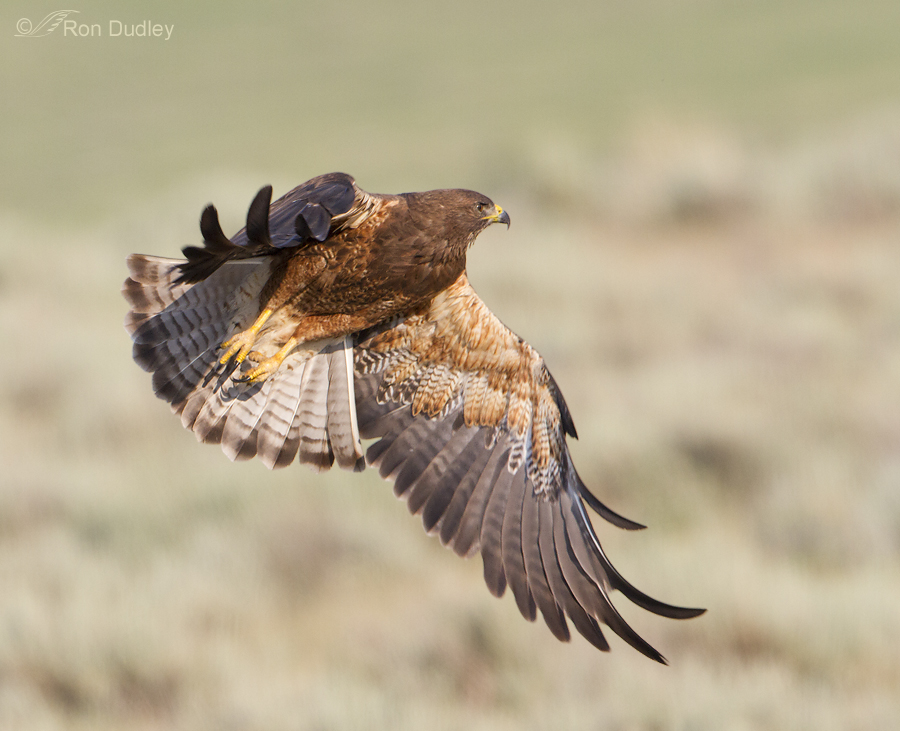
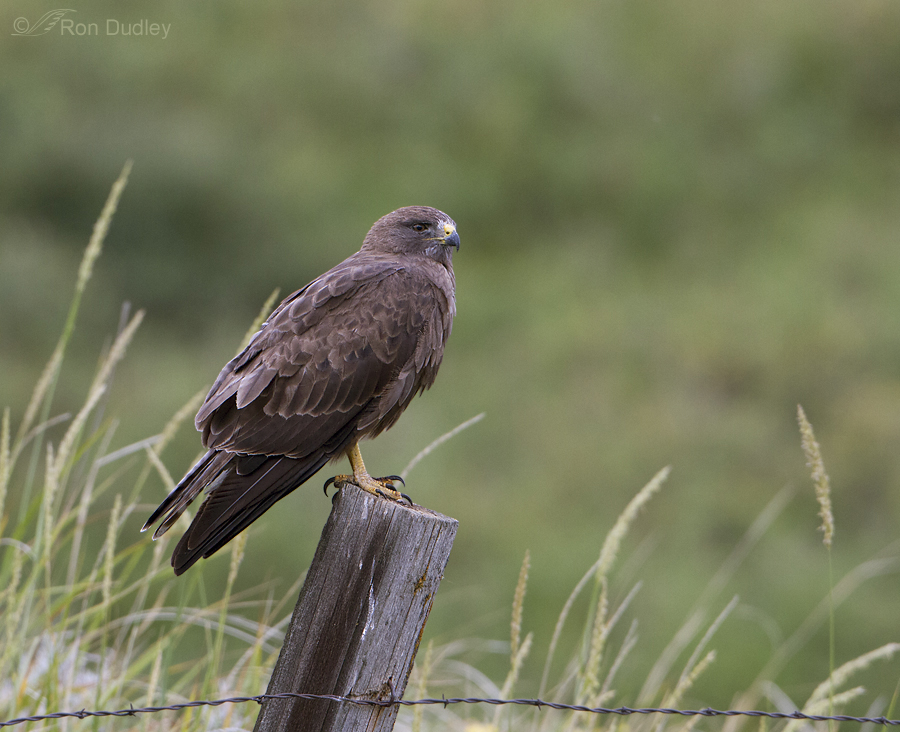
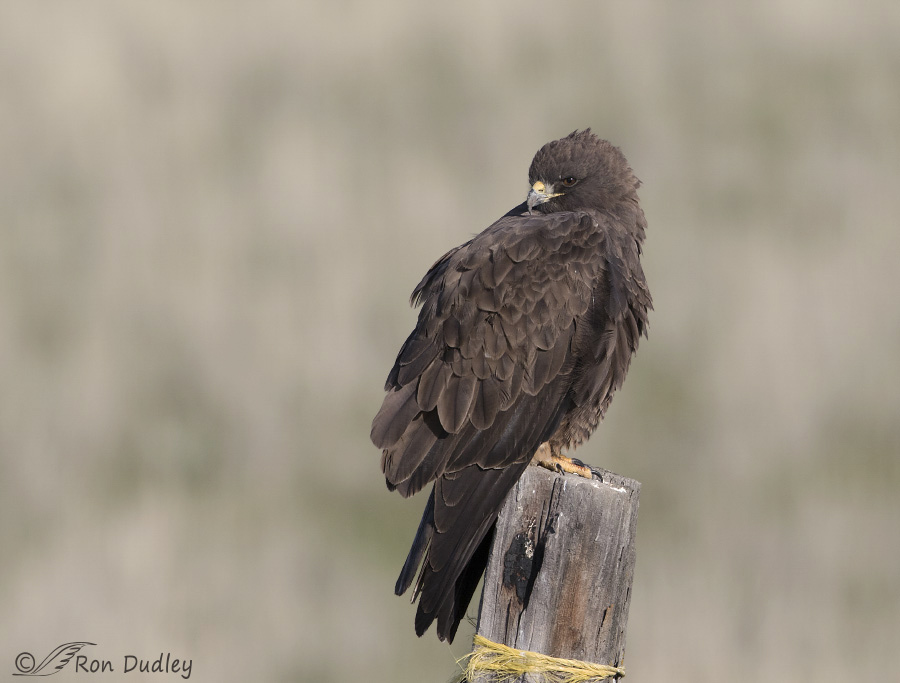
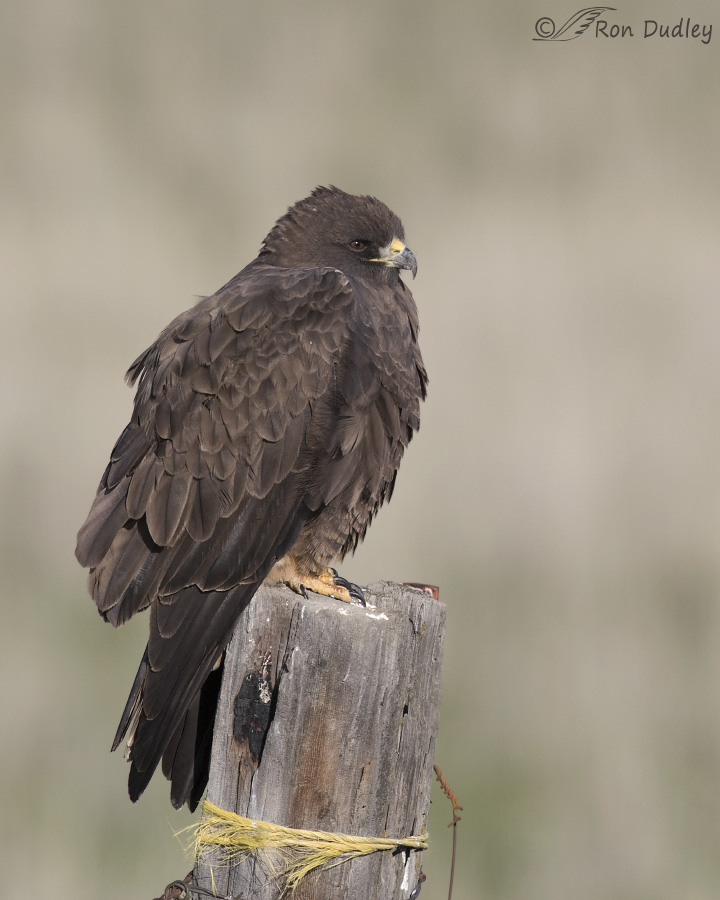
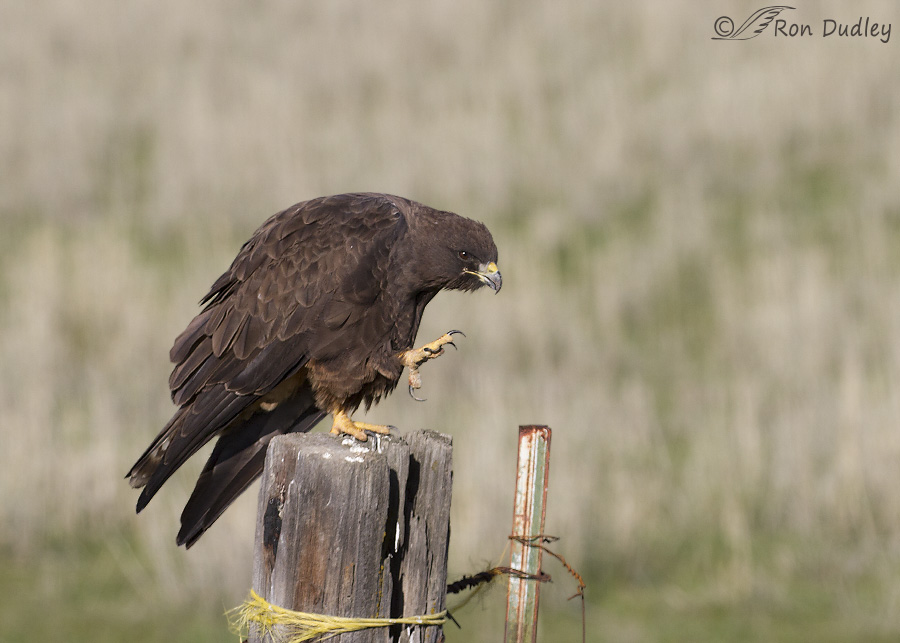
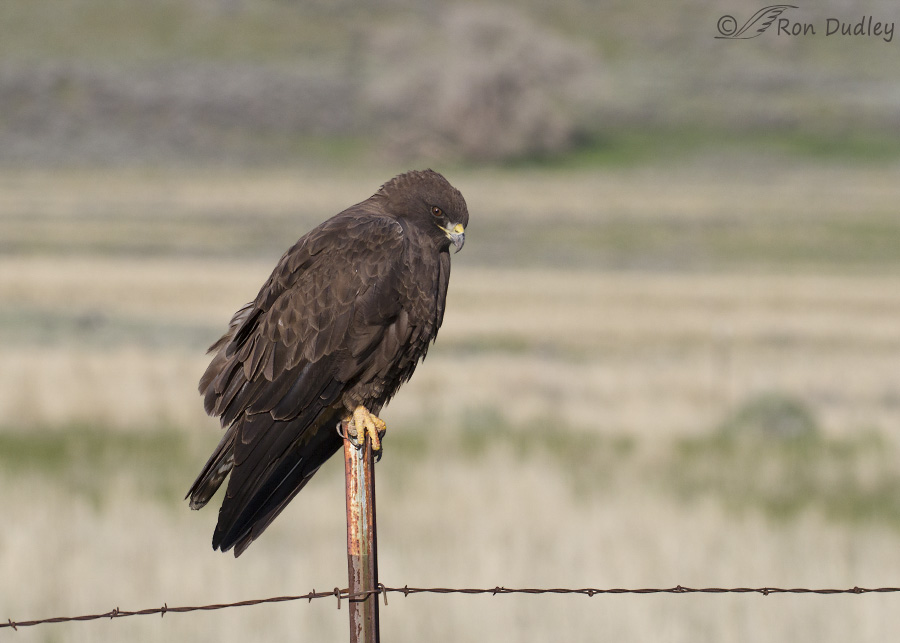
Searching for Lark Sparrows i found this interesting blog with beautiful images.
I’m close to the Bear River wildlife refuge, so I will sign up, along with Mia’s.
Welcome to Feathered Photography, Utahbooklover.
Majestic.
Magnificent.
Marvellous.
And rather a lot of other superlatives.
Thank you, EC.
Wow, they are all so pretty. Lucky you!
I had “pretty” subjects, Jean. Thanks.
These photos could be a great start for a book about raptors. Beautiful images complemented with a clear and very informative speech.
My fingers are crossed and I’m hoping that one day that book will come out for the great pleasure of all your readers.
Thank you very much for today’s lesson.
Thanks so much for your confidence in me and my photographs, Jorge. That means a lot.
Wonderful pics and info about the color morphs of these gorgeous birds! I have never seen a Swainsons hawk of any sort. Perhaps someday…
I hope you get to see some one day, Joanne. My world would be diminished without them.
Wonderful and informative series. I learn so much from your blog. I often picture you in a classroom and imagine what fun your students had.
Thanks, Marty. I often had just as much fun as they did!
WOW! What great pictures and a neat lesson on the three color morphs!
I wonder if the reason the dark morph is so rare is that it is a purebred for that color type surrounded by so many hybrids? I’m sure it is more complicated than that, but it sure is interesting! They (avian biologists) must have the DNA for each of these color morphs, are there avian geneticists that have published about these different color genes? I haven’t read anything, just asking. I would think it would hold true for the various color morphs of other bird species as well.
Thank you, Dick. I don’t know the answers to your question but I wish I did…
You were lucky, indeed, to get so many beautiful photos of these majestic looking hawks. It is wonderful to see this through your eyes and gain knowledge through your comments. Thank you.
Thanks very much, Alice.
I like them all, from light to dark to darkest! (“Coy Boy” is quite beautiful.) So interesting that there are so many color variations within a single species. See, I think it’s a conspiracy to ensure that I can never really be certain of what I’m looking at! But, I just love hawks, so no matter. Thanks for a great start to my Monday morning!
Chris, it can get even more complicated than I’ve presented it here. Some folks include a fourth morph – rufous. These categories can be convenient but they’re somewhat arbitrary and variation is continuous from lighter to darker.
Oh, now that’s just cruel!
Oh what a beauty! I’m a fool for the dark morphs (and the individual diversity overall), especially when you see them as the light of the setting sun plays with the colors in those feathers! One of the California falconers made an outstanding video (“The Road to Bakersfield”) that included his dark morph redtail, and when the late sunlight hit that bird’s red tail, well, let’s just say the colors exploded in flames and my jaw dropped to the ground.
Another thing that dropped my jaw to the ground was when bright sunlight revealed violet hues in Mariah’s brown feathers!! VIOLET? Who would have expected THAT? There are so many wonders in The Great Out There!
Thank you, Laura.
Stunning and beautiful…love the example photos as much as the dark morph bird you photographed the other day. Your pictures are bright, crisp and always a pleasure to look at.
Thanks for the kind words, Zaphir.
Simply stunning series and info Ron! Thanks for sharing!
Charlotte
Thank you, Charlotte.
It is gorgeous.
Agreed. I had a great “model”.
And then there are all the variations of color the juveniles have! Swainson’s are the hardest for me to quickly identify. I have to have a good look at the face.
April, yes that (usual) white on the face is often key for ID. And you’re certainly right about the juvies. I absolutely love the butterscotch colors that many of the juveniles have.
Beautiful photographs Ron, of all the morphs! That is indeed one nice dark morph Swainsons Hawk. Chocolate brown.
Thanks very much, Ed.
Gorgeous bird/photographs, Ron and quite the tutorial on the “morph” thing. To the uninformed one would think they were different species.
I sometimes thought the same thing when I first started learning more about raptors, Judy. It’s an understandable mistake to make. Thank you.
I love the ‘coy’ shot, too! I think he stuck around because he likes you!
Ha, then I hope “he’s” really a she…
That first shot is poster perfect! Thanks for the share.
I’m glad you like it, Elmer.
A very interesting series…each is a great shot on its own…I had no idea there was so much variety in these these noble-looking birds…I wouldn’t have known they were the same kind…as I’ve said before, I’ve never yet seen one of your blogs without learning something interesting and new…
Patty, it’s very easy and understandable to assume these widely varying Swainson’s color morphs are different species. I remember being blown away by it when I first started photographing birds and learning more about raptors.
Thanks very much for your kind comment about learning new things here on Feathered Photography.
Beautiful! Thanks Ron!
Thank you, Gail.
Hi Ron beautiful series !!! Will he stay this way??? For how long??? The male swainson that nests on my property is dark morph every year and the female is always light just wondering about that.. is that how it usually is??? Male dark female light??
Thanks, Marina. Yes this hawk will stay dark. Any morph can mate with any morph. Most pairs I see are either light/light or light/intermediate.